Air Arabia Airline, Arrival at Baku Airport
- G9924 Kuala Lumpur - Sharjah
Departure: 03:35
Arrival: 06:50
- G9305 Sharjah - BAKU
Departure: 08:00
Arrival: 10:50
- G9244 Yerevan - Sharjah
Departure: 17:40
Arrival: 20:35
- G9923 Sharjah - Kuala Lumpur
Departure: 21:40
Arrival: 08:50 (+1)
Day 1: Baku - Arrival
Arrival in Baku in the morning. You will be met by our tour guide and transfer to the hotel. After check-in, start sightseeing tour in Baku:
When you walk through Martyrs’ Lane, you will find a beautiful view overlooking Baku’s coastline. Continue touring new Baku and exploring the architecture of the 19-20th centuries: Nizami Street, Fountain Square, Nizami Ganjavi monument, Rasul-Zade Street.
- Icheri Sheher
Sometimes called the Old Town or the Inner City, Icheri Sheher is a unique historical ensemble right in the center of Baku, at the heart of the city. Ancient Baku was founded where Icheri Sheher is today, which used to be right on the shores of the Caspian Sea.
- Gyz Galasy
The most magnificent and mysterious landmark in Baku and in Icheri Sheher is the Maiden Tower, or Gyz Galasi in Azerbaijani. Because of its unique shape and design, Maiden Tower has become the unofficial symbol of Baku.
- Shirvanshah Palace
The Shirvanshahs ruled the area now known as Azerbaijan for almost 700 years, building and developing the region. For most of their reign, which started in 861, the shahs made their capital in Shamakhi, but from 1382 to 1500, they lived in Baku.
- Multani Caravanserai
It is in the old part of town - Icherisheher. This caravanserai was built in the 15th century for Indian merchants, fire worshipers, who came from the city of Multan in India (present-day territory of Pakistan).
- Carpet Museum
Azerbaijan Carpet Museum displays Azerbaijani carpets and rug items of various weaving techniques and materials from various periods. It has the largest collection of Azerbaijani carpets in the world.
O/N Baku Day 2: Baku - Absheron Peninsula - Gobustan - Baku
Today you will visit the area of the Greater Baku and Absheron Peninsula. Start with:
- Gobustan National Park
Gobustan State Reserve located west of the settlement of Gobustan, about 40 miles southwest of the centre of Baku was established in 1966 when the region was declared as a national historic landmark of Azerbaijan to preserve the ancient carvings, mud volcanoes and gas-stones in the region.
Start with Gobustan National Park. Pay a visit to the Petroglyphs Museum and explore petroglyphs dating back to 10,000 BC. Continue to the mud volcanoes in Gobustan Reserve. Gobustan is home to almost half of the world’s mud volcanoes. Later drive to:
- Ateshgah Temple
The Temple of Eternal Fire - Ateshgah - is an authentic Azerbaijani exotic. It is well-known practically all over the world. It is located 30 km from the centre of Baku in the suburb of Surakhany.
- Yanar Dag, Baku Vicinity
Azerbaijan is historically called the Land of Fire, and it is not for the sake of a witty remark. At a whim of nature, the land of this Caucasian country located on the picturesque coast of the Caspian Sea is replete with underground sources of oil and gas that long for blowing out.
O/N Baku Day 3: Baku - Lahij - Kish - Sheki
[4 h 20 min (299 km)] In the morning, depart Baku and drive to Sheki. On the way, visit:
Continue to Shamakha and see the:
- Juma Mosque
Many of the architectural monuments of Baku were built on the ruins of very old buildings belonging to the pagan period in the history of Azerbaijan. Thus, according to archaeologists, the Maiden Tower is built on the site of a pagan temple.
- Yeddi Gumbez
At the foot of Gulistan Fortress is located Yeddi Gumbez Mausoleum or “Seven Domes”. This is how people named Shamakhi tomb of Shirvan Dynasty rulers. There the notorious representatives of Shirvan Dynasty were buried.
Drive through the Girdimanchay River Canyon to visit:
- Lagich (Lahic, Lahij, Lahich)
A 5th century place rich in its historic and architectural values. Lahij is an ancient village with charming eye-catching sidewalks inlaid with stones. It is famous for its medieval water supply and sewage systems, as well as traditional jewelry, copperware, carpets, pottery, daggers, and iron tools workshops.
Continue driving to Sheki. On the way, visit:
O/N Sheki Day 4: Sheki - Georgian border - Kvareli - Gremi - Telavi
[3 h 5 min (192 km)] Check out from hotel and start sightseeing tour in Sheki. Visit Sheki medieval fortress, Sheki Khans Palace, local History Museum, handicrafts workshop, mosque-madrassah, and local bazaar.
towards the border with Georgia (115 km, ~2 h.). Cross the border, meet your Georgian guide and start exploring the eastern part of Georgia, famous for its viticulture and winemaking traditions. We will pass through the beautiful landscapes of vineyards and wine-producing villages. Continue to:
- Gremi, Georgia
Standing above the green valley of Alazan, Gremi attracts travellers whose road goes between Telavi and Kvareli. Gloomy and monumental, the castle is one of the most visited tourist points in Georgia.
Then reach Telavi, the administrative centre of Kakheti region. Have a short drive around the town.
O/N Telavi 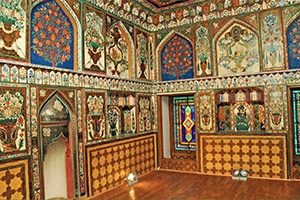 Sheki Khans’ Palace
Sheki Khans’ Palace 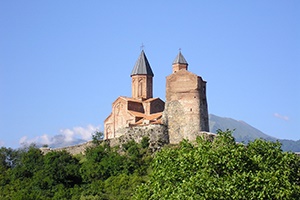 Gremi, Georgia
Gremi, GeorgiaDay 5: Telavi – Tsinandali – Bodbe – Sighnaghi – Tbilisi [1 h 50 min (94.5 km)]
After breakfast, continue exploring Kakheti by visiting
- House Museum of Chavchavadze in Tsinandali
The manor in the village of Tsinandali is an ancestral estate, a palace of the princely family of Chavchavadze. There are many amazing, beautiful and tragic events in the history of Georgia relate to this family.
- Bodbe
The St. George’s Monastery of St. Nino, sometimes also called the Bodbe Monastery, is one of the most important religious sites in Georgia.
- Sighnaghi
The Georgian town of Sighnaghi is in the eastern part of Kakheti, and is known as the City of Love. Sighnaghi was also one of Georgia’s many stops along the ancient Silk Road.
In the afternoon, head to Tbilisi for overnight.
O/N Tbilisi Day 6: Tbilisi
In the morning, start a sightseeing tour in Tbilisi. Start at:
- Sameba Cathedral
Built in the year 2004, the Holy Trinity Tsminda Sameba Cathedral is also called the symbol of new Georgia. The beauty and sizes of the cathedral are indeed breathtaking, and rises magnificently on the hill of the St. Ilya, on the left bank of the Kura River.
- Metekhi Temple
Yet another ancient monument of Tbilisi is Metekhi temple (the 12th century) standing close to the edge of the rocky bank of the Kura which was the fortress and the residence of Georgian tsars.
- Narikala Fortress
The Holy Mountain Mtatsminda hosts the fragments of ancient Narikala fortress. It is the most known and ancient monument of Tbilisi’s antiquity; the townspeople call it “the heart and soul of the city”.
Walk down to the district of Sulphur bath houses passing by the only mosque in Tbilisi. Stroll through the Sharden area full of narrow streets with cozy cafés, wine tasting bars, souvenir shops, and breathe in the living past. Visit:
- Sioni Cathedral
Sioni or Zion Cathedral in the name of the Assumption of the Mother of God is one of the most known monuments in the Old Town.
- Anchiskhati Church
In the Old Town, there is the ancient acting St. Mary Church constructed during the reign of Dacha Udzharmeli, the successor of Vakhtang Gorgasali, in the 4th century. The beautiful rectangular building of the church was built under the influence of ancient Palestinian architecture.
- Rezo Gabriadze Theatre
“Georgian national treasure” - this is how Mr. Rezo Gabriadze, one of the most talented art professionals, is recognized worldwide. His influence on the Georgian culture has been lasting and profound.
- The Bridge of Peace
Relatively newly constructed the Bridge of Peace is the attraction one wouldn’t want to miss in Tbilisi. It is a pedestrian glass and steel bridge in a bow-shaped design that sits over the Mtkvari (Kura) river in the Georgian capital.
- Rike Park
Rike park is the youngest recreational area in Tbilisi. It is situated on the left bank of the river Kura (Mtkvari) and already has become a popular place for both local and international visitors, especially families, and in summer.
- Georgian Museum of Folk Architecture
The Open-Air Museum of Ethnography is located 3 km south-west from Tbilisi at the Turtle Lake. It was founded in 1960. As of today, one of the most visited museums in Georgia includes a collection exceeding a hundred exhibits.
In the evening, visit a local restaurant to taste dishes of traditional Georgian cuisine and enjoy folklore show.
O/N Tbilisi Day 7: Tbilisi - Mtskheta - Gori - Uplistsikhe - Tbilisi
After breakfast, drive to:
- Mtskheta
Mtskheta is Georgia’s most sacred pilgrimage city and has been declared a UNESCO World Heritage Site. One of the oldest towns and the cultural and religious centre of Georgia. Mtskheta was the capital of the Eastern Georgian Kingdom of Iberia from the third century BC.
- Jvari
Jvari monastic temple immortalized by Michael Lermontov (“Mtsyri” poem) is the most ancient cult monument constructed at the beginning of Georgian Christianity in the 6th century (585- 604). The name Jvari means “cross” in the Georgian language.
- Svetitskhoveli
Not far from Dzhvari there is another cult monument of Christian Georgia - one of the major Orthodox Georgian temples - Svetitskhoveli Cathedral. It was built in the 11 th century (1010-1029) on the site of the Twelve Apostles Church, the first Christian Georgian church erected in the 4th century.
Continue to Gori and visit:
- Stalin Memorial House-Museum
In the very center of the town like a bright spot in, the background of old structure stands a huge palace built in the original Gothic style. This is Stalin Memorial Museum which was constructed in the 1950s.
- Uplistsikhe
10 km from Gori on the bank of the river Kura there stands one of the rarest monuments in the world - the ancient fortified city Uplistsikhe cut inside the volcanic rocks of the Kvernaki ridge. It was first mentioned in the annals of the 1st century BC and prospered in the 9th-10th centuries.
Drive back to Tbilisi for overnight
O/N Tbilisi Day 8: Tbilisi - Armenian border - Haghpat - Lake Sevan - Sevanavank - Yerevan
[5 h 10 min (276 km)] At 09:00, our driver will meet you at your hotel in Tbilisi and transfer to “Sadakhlo-Bagratashen” Georgian-Armenian border point. Cross the border, meet your Armenian guide and driver and start the journey to the land of ancient traditions and oldest temples. Drive to:
- Lori Region
The marz (province) of Lori is in the northeast of Armenia, bordering Georgia. This marz is famous for its mild climate since the Lori-Pambak Mountains stand in the way of cold winds from the north. Including Haghpat Monastery, a UNESCO World Heritage Site. This stunning example of Armenian traditional architecture erected in 10-13th centuries stands on a hillside beautifully overlooking the Debed River.
- Sevan Lake
Ancient relict Sevan Lake - “The Jewel of Armenia” or the “Geghama Sea” is one of the largest high-mountainous fresh water lakes in the world and the main attraction not only Gekarkunik, but whole Armenia.
- Sevanavank Monastery
In the northwest part of Sevan Lake, on a narrow rocky peninsula, there stands one of the most prominent examples of medieval Armenian architecture - Sevanavank Monastery.
Reach the capital of Armenia for overnight at the hotel.
O/N Yerevan Day 9: Yerevan - Khor Virap - Areni - Tatev - Goris
[3 h 45 min (237 km)] After breakfast at 09:00, head to:
Continue to Areni, a city known for producing famous Armenian wine from pomegranate and apricot. Then drive to:
- Tatev Monastery
The jewel of medieval Armenian architecture, Tatev, was constructed in the 9th-13th centuries. In the past, Tatev was difficult to reach, because the winding road had to descend the steep walls of a gorge, and cross a river on the Devil’s Bridge, but now Tatev is easily accessible by the world’s longest reversible cable car.
Arrival in Goris at 18:00, accommodation at hotel
O/N Goris 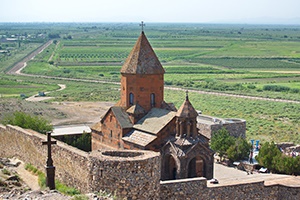 Khor Virap Monastery
Khor Virap Monastery 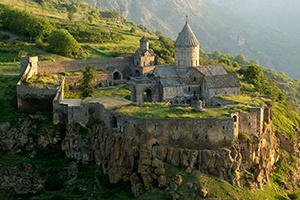 Tatev Monastery
Tatev MonasteryDay 10: Goris - Noravank - Yerevan
[3 h 50 min (237 km)] After breakfast at 09:00 check out from the hotel. On the way to Yerevan visit:
- Noravank Monastery
Noravank means “New Monastery” in Armenian. However, today this name does not fit, as the monastery is already more than seven centuries old. The beautiful Noravank Monastery was built in the 13th century on the edge of narrow winding gorge above the Amaghu River, near the city of Yeghegnadzor.
Arrive in Yerevan, check-in to the hotel. Free time for last shopping.
O/N Yerevan 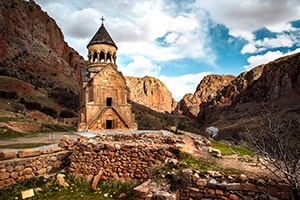 Noravank Monastery
Noravank MonasteryDay 11: Yerevan - Checkout
check-out from the hotel at 11am. Transfer to Yerevan International Airport. End of the tour.
This 11-days Caucasus tour covers Azerbaijan, Georgia and Armenia, taking you deep into the history and culture of these fascinating countries. You will feel at home among welcoming people and beautiful scenery, from the medieval architectural monuments nestled in mountain landscapes to the delicious cuisine, filled with fresh bread, roasted meats, rich cheese, and fine wines. Head from the shores of the Caspian Sea in Azerbaijan to the charming churches of Georgia to the Rocky Mountains of Armenia, with stops at historical and cultural sights and guided tours to introduce you to everything you need to know. This is the best private tour for those who are interested in the Caucasus, or even just in exploring something new.
ACCOMODATION | City | 3* & 4* HOTELS | Night |
| Baku | Central Park Hotel or similar | 2 |
| Sheki | Issam Hotel & Spa Hotel or similar | 1 |
| Telavi | Old Telavi Hotel or similar | 1 |
| Tbilisi | Hotel Tiflis or similar | 3 |
| Yerevan | Cascade Hotel or similar | 2 |
| Goris | Mirhav Hotel or similar | 1 |